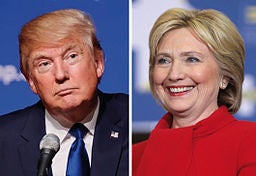
The current election cycle has caught the attention of many Americans who previously were not engaged in the electoral process. Yet many of these intelligent, educated, credentialed new voters are susceptible to the same subliminal influences as lifelong voters. We are all the same when it comes to the tendency to be influenced by factors other than partisan policy promises.
On the eve of election day, both sides are speculating about the projected impact of new voters. While some have noted that many new voters are not necessarily voting early, [1] everyone is aware of the impact these citizens could have on influencing the outcome of the election.
For citizens wading into the election process for the first time, what are they looking for in a candidate? This question may be more revealing than voters want to admit. When it comes to evaluating the options, it is true that people are not just reading and listening, they are looking.
When it Comes to Candidate Image, Viewers are Voters
Airline passengers often leaf through the on-board complimentary magazine looking at the pictures instead of reading the articles. Are voters doing the same thing when deciding who should be the next leader of the free world? Possibly. That is a troubling thought.
Research indicates that citizens “vote with their eyes, rather than their minds.” [2] The result? Better-looking candidates do better in political elections. [3] The attractiveness bias can persist even when additional information about the candidate comes to light. [4]
Studies have consistently demonstrated that good-looking political candidates enjoy more favorable evaluations than their less attractive counterparts. [5] How significant is the power of attraction? Attractiveness is more highly linked with electoral success than either trustworthiness or perceived competence. [6] Both Donald Trump and Hillary Clinton could benefit from this reality, as this result holds true for both male and female candidates. [7]
Easier to Look Than Listen
You might wonder, don´t voters both look and listen? Not always. Despite the time and effort candidates spend on outlining the details of economic plans, trade deals, and foreign policy, many voters are too busy to become familiar with the particulars of each candidate’s platform—or even with the issues in general. Voters who remain ignorant of political specifics may be more likely to be influenced by a candidate´s personal characteristics. [8]
Voters who lack detailed information about candidates yet view their photos on the ballot tend to view attractive candidates as possessing qualities associated with successful politicians. [9] This is a result of voters taking cognitive shortcuts in making voting decisions. [10] In forming impressions through photographs, voters are also influenced by demographic cues, which may bias them in favor of particular attributes. [11]
Some voters may actually attempt to “correct” for candidate attractiveness in order to avoid being biased in their evaluation. [12] Such correction may decrease, eliminate, or even reverse the positive effect of physical attractiveness. [13] However, because correction requires cognition, [14] voters who are distracted or uninformed are less likely to correct for the physical attractiveness effect. [15]
Listening Instead of Looking: Hearing Perfect Pitch
Thankfully, most voters both look and listen. Yet even if you turned away from the television, determined to judge a candidate speech not merely by what you saw, you would be influenced by what you heard. Because even with your eyes closed, your ears are open. And research demonstrates that candidate voice pitch influences voters. [16]
Hillary Clinton´s weekend speeches were delivered with vitality, vigor, and volume. Lots of it. As her cheering crowds became louder, so did she. Research demonstrates that pitch matters.
Some research indicates that generally, both genders prefer candidates with lower pitched voices. [17] This preference is particularly pronounced when evaluating female candidates—a finding generating speculation that voice pitch may explain why women are under represented in leadership roles. [18]
Look, Listen, and Learn: Mind Over Matter
Thankfully, most voters take a variety of factors into consideration before going to the polls. For the serious voter, candidate appearance and tone of voice are factors to consider, among many others.
Many voters intentionally vote with their minds by acquiring information to supplement (or contradict) visual and verbal impressions. They learn all they can about the candidates in order to discern the person behind the persona. Sure enough, studies show that for well-informed voters, looks matter less.
New voters are well advised to use all of their senses in making their all-important decision at the polls.
Portions of this article first appeared in Psychology Today
References:
[2] Carl L. Palmer and Rolfe D. Peterson, ”Halo Effects and the Attractiveness Premium in Perceptions of Political Expertise,” American Politics Research Vol. 44, No. 2 (2016): 353-382 (356).
[3] Palmer and Peterson, ”Halo Effects,” at 356.
[4] Palmer and Peterson, ”Halo Effects,” at 356.
[5] William Hart, Victor C. Ottati, and Nathaniel D. Krumdick, “Physical Attractiveness and Candidate Evaluation: A Model of Correction,” Political Psychology, Vol. 32, No. 2, (2011): 181-203. doi: 10.1111/j.1467-9221.2010.00812.x.
[6] Niclas Berggren, Henrik Jordahl, and Panu Poutvaara, ”The Looks of a Winner: Beauty and Electoral Success,” Journal of Public Economics Vol. 94 (2010): 8-15 (8).
[7] Berggren et al., ”The Looks of a Winner,” at 8.
[8] Berggren et al., ”The Looks of a Winner,” at 8.
[9] Susan A. Banducci, Jeffrey A. Karp, Michael Thrasher, and Colin Rallings, “Ballot Photographs as Cues in Low-Information Elections,” Political Psychology, Vol. 29, No. 6 (2008): 903-917.
[10] Banducci et al., ”Ballot Photographs,” at 903-904.
[11] Banducci et al., ”Ballot Photographs,” at 904.
[12] Hart et al., ”Physical Attractiveness.”
[13] Hart et al., ”Physical Attractiveness.”
[14] Hart et al., ”Physical Attractiveness,” at 182.
[15] Hart et al., ”Physical Attractiveness.”
[16] Casey A. Klofstad, ”Candidate Voice Pitch Influences Election Outcomes,” Political Psychology Vol. xx, No. xx, (2015): 1-14; doi: 10.1111/pops.12280.
[17] Klofstad, ”Candidate Voice Pitch Influences Election Outcomes,” at 1-2.
[18] Klofstad, ”Candidate Voice Pitch Influences Election Outcomes,” at 11.